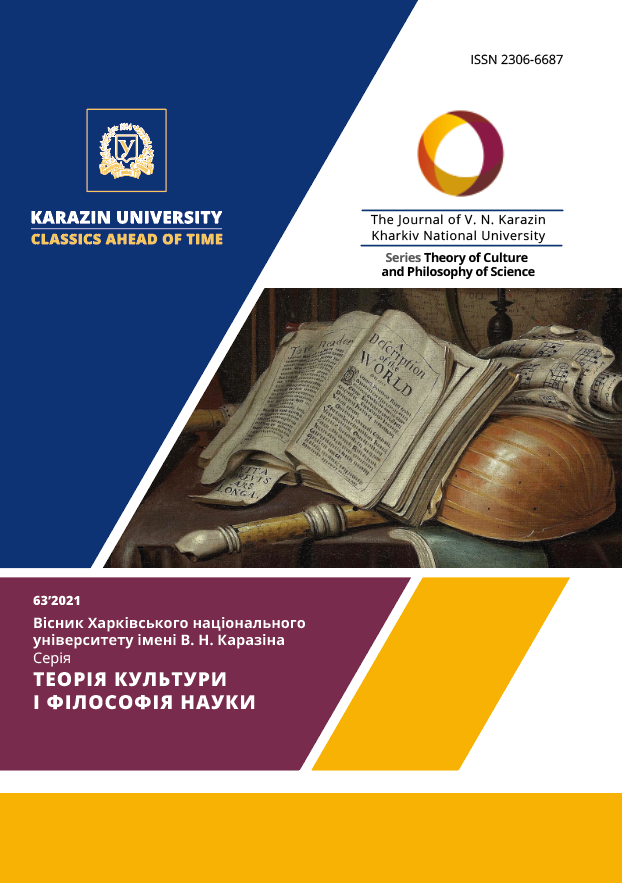«BLACK MOVIES»: ЖАНРОВА ПАМ’ЯТЬ КІНОМОВИ НУАРУ У СИСТЕМІ АУДІОВІЗУАЛЬНИХ ТРАНСФОРМАЦІЙ (1970-ті – 2010-ті рр.)
Анотація
Проблема «жанрової пам’яті» в кіномові нуару є однією із найбільш актуальних у сучасному дослідженні еволюції «чорного» кіно. Зважаючи на те, що за останні декілька десятиліть нуар істотно розширив свою традиційну художню «оболонку», вивчення особливостей та шляхів його трансформації становить один з пріоритетних векторів дослідження. В межах аудіовізуальних трансформацій початку ХХІ століття нуар репрезентований щонайменше двома жанровими конструкціями (пост- та нео-нуар), які також потребують вивчення у контексті проблематики «дифузності» жанрів та «гібридизації» художньої мови кіно. Авторами розглянуті основні етапи формування жанрової парадигми нуару, які визначені та проаналізовані у контексті інструментарію кінематографічної художньої мови: композиційно-пластичиних прийомів, стильових рішень та «жанрової іконографії». Визначаючи три основні періоди в розвитку «чорного» кіно, автори окреслюють його основні типово-видові амплуа, які формують різні стратегії та форми існування класичної «жанрової пам’яті» нуару у різних системах кінематографічного художнього мислення. Нуар засвідчив надзвичайно високу здатність до видозмінення, що обумовило потужність його субжанрової конвенції. На прикладі цілої низки кінострічок показано, як через виражальні засоби кінематографу режисери використовують / запозичують традиційну естетику нуару. У багатьох випадках семіотика «чорного» кіно стає об’єктом для пошуку нових художньо-стильових рішень, що зайве підтверджує жанрову еластичність нуару. Усе зазначене дозволяє констатувати існування в художньому інструментарії кіно, свого роду, «нуарної» онтології, яка на рівні використання конкретного кола прийомів звертається, передусім, до лакуни «жанрової пам’яті».
Завантаження
Посилання
Arnett, R. (2020). Neo-Noir as Post-Classical Hollywood Cinema. Norjolk: Old Dominion University. 208 p. DOI: https://10.1007/978-3-030-43668-1.
Borde, R., & Chaumeton, E. (1995). Towards a definition of Film Noir. In: Film Noir. Reader 1. New York: Limelight Editions. Рp. 17-25.
Leitch, T. (2004). Crime films. Cambridge University Press: University of Delaware. 386 р.
Shires, J. (2020). Cyber-noir: Cybersecurity and popular culture. Contemporary Security Policy, Volume 41. Рp. 1–26. DOI: https://10.1080/13523260.2019.1670006.
Silver, A. (1995). Son of Noir: Neo-Film Noir and the Neo-B Picture. In: Film Noir. Reader 1. New York: Limelight Editions, 1995. Р.331-338. URL: http://intelligentagent.com/noir/Silver.pdf
Sukovataya, V. (2019). Women in noirs style: the soviet version. The Journal of V.N.Karazin Kharkiv National University. Series: Theory of Culture and Philosophy of Science. № 60. Pp. 90-106. DOI: https://10.26565/2306-6687-2019-60-09. (In Ukrainian).
Verevis, C. (2005). Film Remakes. Edinburgh: University Press. 208 p.
Agranovskiy, N. (2011). More than «Easy Rider»: The Way of Director Dennis Hopper. «Artikult»: scientific journal about culture and art. #3. Рp. 49-56. (In Russian).
Bakina, T. (2014). The image of the past and nostalgic experiences in cinema. Moscow: HSE University, 2014. 56 p. (In Russian).
Isniuk, I. (2014). Aesthetics of film noir in the modern artistic space of Ukraine: values, theoretical research and artistic practice. Mandrivets: All-Ukrainian scientific journal. Ternopil: "Mandrivets". №1. Pp. 71-74. (In Ukrainian).
Kudryashov, I. (2016). Post-50s Film noir: Death, Development, or Postmodern Quotes? Criticism and semiotics. # 1. Pp. 236-252. (In Russian).
Lure, Ya. (2013). Films by David Lynch: stylistics, imagery, author's manner. «Artikult». Faculty of Art History: Scientific Electronic Journal. # 9. Pp. 32-41. URL: https://cyberleninka.ru/article/n/filmy-devida-lincha-stilistika-obraznost-avtorskaya-manera/viewer (In Russian).
Nelyubin, A. (2013). The transformation of the American "tough" detective in the novel by D. Kavanagh (J. Barnes) "City of Scammers". Perm University Bulletin. #1 (21). Pp. 135-139. (In Russian).
Nyagolova, N. (2014). Semiotics of Suicide in «The Big Chill» by Lawrence Kasdan. NLO: new literary review. #6 (130). URL: https://www.nlobooks.ru/magazines/novoe_literaturnoe_obozrenie/130_nlo_6_2014/article/11208/ (In Russian).
Ponomareva, E. (2017). Genre and stylistic organization of the collection of small prose "Moscow noir". Chelyabinsk: YuUrGU. 85 p. (In Russian).
Prohorova, K. (2018). Features of the interpretation of the story "The Assassins" by E. Hemingway in the film adaptation by Robert Siodmak. The facets of science. T.6. # 3. Pp.18-21. (In Russian).
Reshetylo, I. (2013). Translation of intertextual elements in film reviews. Language, consciousness, artistic creativity, the Internet in the mirror of modern philological studies. Collection of scientific works. Kyiv, Kyiv University or Shevchenko University, Kyiv University Publishing and Printing Center. Pp. 276-286. URL: http://www.library.univ.kiev.ua/ukr/host/viking/db/ftp/books/other/mova_svidomist_2013.pdf
Sklyarova, Ya. (2015). German Cinema Expressionist Traditions in American Noir Fylms of the 1940s-1950s. «Artikult» Faculty of Art History: Scientific Electronic Journal. # 18 (2). Pp. 62-65. URL: http://articult.rsuh.ru/articult-18-2-2015/j-a-sklyarova-traditions-of-the-german-genexpression-in-american-films-noir-of-1940-1950.php (In Russian).
Fedorovich, B. (2013). Postmodernism and its understanding in the contemporary artistic space: regional practices (on the example of the Moscow Arts Week of the First Moscow International Performance Festival and the Weeks of Contemporary Art in Lviv). Culture, art, education: problems and development prospects: materials of the scientific-practical conference. Smolensk: SGII. 536 p. (In Russian).
Fedorchenko, O. (2011). Features of the translation of a psychological cinema thriller. Scientific Bulletin of Kherson State University. # 14. Pp. 313-318.
Filonenko, S. (2014). 100 shades of black: noir as a genre and style in modern mass literature. Scientific notes of Berdyansk State Pedagogical University. # II. Pp. 24-31.
Hakimzyanova Ya. (2018). «Tess of the D'Areberville family» in cinematography: reflections on the film adaptation of Roman Polanski. Topical issues of philological science of the XXI century: collection of articles VII Int. scientific. conf.: Part II. Yekaterinburg. Pp. 183-189. (In Russian).




